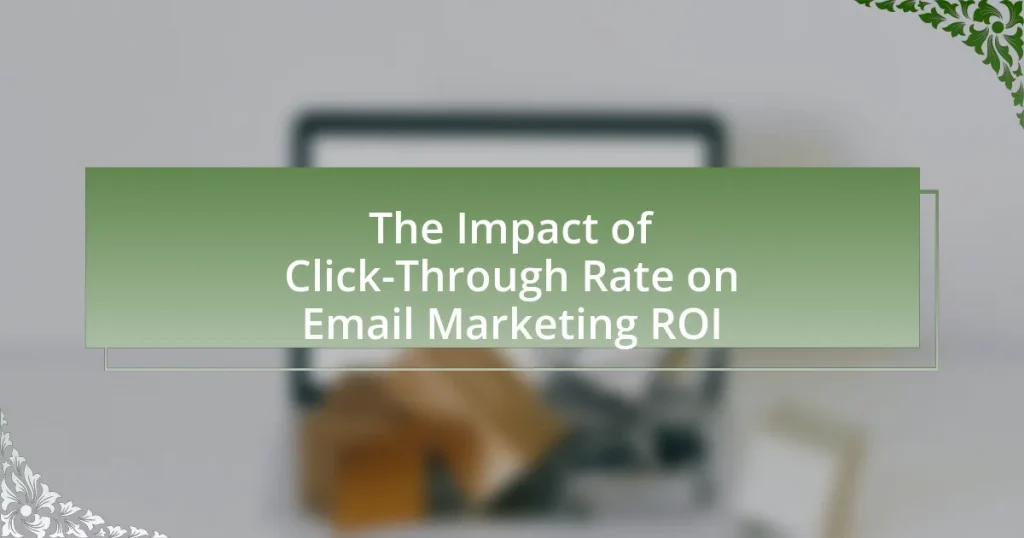The article focuses on the Click-Through Rate (CTR) in email marketing and its significant impact on Return on Investment (ROI). It defines CTR as the percentage of email recipients who click on links within an email, emphasizing its role in measuring engagement and campaign effectiveness. The article details how CTR is calculated, the metrics involved, and its distinction from other email marketing metrics. It also explores strategies for improving CTR, such as audience segmentation and A/B testing, and discusses the implications of both high and low CTR on overall marketing success and revenue generation.

What is the Click-Through Rate in Email Marketing?
The Click-Through Rate (CTR) in email marketing is the percentage of recipients who click on one or more links contained in an email. This metric is crucial as it directly indicates the effectiveness of an email campaign in engaging its audience. For instance, a CTR of 2% means that out of 100 recipients, 2 clicked on the links provided. According to a report by Mailchimp, the average CTR across all industries is approximately 2.6%, highlighting the importance of optimizing email content to improve engagement and drive conversions.
How is Click-Through Rate calculated in email campaigns?
Click-Through Rate (CTR) in email campaigns is calculated by dividing the number of unique clicks on links within the email by the total number of emails delivered, then multiplying by 100 to express it as a percentage. For example, if an email campaign is sent to 1,000 recipients and 50 unique clicks are recorded, the CTR would be (50/1000) * 100, resulting in a 5% CTR. This metric is crucial as it directly reflects the effectiveness of the email content in engaging recipients and driving them to take action, thereby influencing the overall return on investment (ROI) of email marketing efforts.
What metrics are used to determine Click-Through Rate?
Click-Through Rate (CTR) is determined using two primary metrics: the number of clicks on a specific link within an email and the total number of emails delivered. The formula for calculating CTR is (Total Clicks / Total Emails Delivered) x 100. This calculation provides a percentage that reflects how effectively an email campaign engages its recipients. For example, if an email is delivered to 1,000 recipients and receives 50 clicks, the CTR would be (50 / 1000) x 100, resulting in a 5% CTR. This metric is crucial for assessing the effectiveness of email marketing strategies and optimizing future campaigns.
How does Click-Through Rate differ from other email marketing metrics?
Click-Through Rate (CTR) differs from other email marketing metrics by specifically measuring the percentage of recipients who click on one or more links within an email, directly indicating engagement with the content. Unlike metrics such as open rate, which only tracks how many recipients opened the email, CTR provides insight into the effectiveness of the email’s call-to-action and overall content appeal. For example, a high CTR suggests that the email successfully motivated recipients to take action, while a low CTR may indicate that the content did not resonate or that the call-to-action was unclear. This distinction is crucial for evaluating the performance of email campaigns and optimizing future strategies.
Why is Click-Through Rate important for email marketing?
Click-Through Rate (CTR) is important for email marketing because it directly measures the effectiveness of email campaigns in engaging recipients. A higher CTR indicates that a greater percentage of recipients are clicking on links within the email, which correlates with increased customer interest and potential conversions. According to a study by Mailchimp, the average CTR for email campaigns across industries is around 2.6%, and campaigns that exceed this average often see a significant boost in sales and customer engagement. Thus, monitoring and optimizing CTR is crucial for maximizing the return on investment (ROI) of email marketing efforts.
What role does Click-Through Rate play in measuring campaign success?
Click-Through Rate (CTR) is a critical metric for measuring campaign success as it indicates the percentage of recipients who clicked on a link within an email compared to the total number of emails delivered. A higher CTR signifies effective engagement and interest in the campaign content, directly correlating with improved conversion rates and return on investment (ROI). For instance, according to a study by Mailchimp, the average CTR for email campaigns across industries is approximately 2.6%, and campaigns that exceed this benchmark often see significantly higher sales and customer interactions. Thus, CTR serves as a vital indicator of how well a campaign resonates with its audience, guiding marketers in optimizing future strategies.
How does Click-Through Rate influence subscriber engagement?
Click-Through Rate (CTR) directly influences subscriber engagement by indicating the effectiveness of email content in prompting recipients to take action. A higher CTR signifies that subscribers find the content relevant and compelling, leading to increased interaction with the brand. For instance, according to a study by Mailchimp, emails with a CTR of 2.5% or higher typically correlate with higher engagement metrics, such as time spent on the website and subsequent purchases. This demonstrates that as CTR increases, so does the likelihood of subscribers engaging further with the brand, ultimately enhancing overall email marketing ROI.

How does Click-Through Rate affect Email Marketing ROI?
Click-Through Rate (CTR) directly influences Email Marketing ROI by determining the effectiveness of email campaigns in driving user engagement and conversions. A higher CTR indicates that a greater percentage of recipients are clicking on links within the email, which typically leads to increased sales or desired actions, thereby enhancing the overall return on investment. For instance, according to a study by Mailchimp, emails with a CTR of 2.5% or higher can significantly boost revenue per email sent, demonstrating a clear correlation between CTR and ROI. Thus, optimizing CTR is essential for maximizing the financial returns of email marketing efforts.
What is the relationship between Click-Through Rate and ROI?
Click-Through Rate (CTR) directly influences Return on Investment (ROI) in email marketing by determining the effectiveness of campaigns in driving user engagement. A higher CTR indicates that a greater percentage of recipients are clicking on links within the email, which typically leads to increased conversions and sales, thereby enhancing ROI. For instance, a study by Mailchimp found that emails with a higher CTR can yield up to 3 times more revenue per email sent compared to those with lower CTRs. This correlation demonstrates that optimizing CTR is crucial for maximizing the financial returns of email marketing efforts.
How can a higher Click-Through Rate lead to increased revenue?
A higher Click-Through Rate (CTR) leads to increased revenue by driving more traffic to a website or landing page, which enhances the likelihood of conversions. When more users click on email links, the potential for sales or lead generation rises, as evidenced by studies showing that a 1% increase in CTR can result in a proportional increase in revenue. For instance, according to a report by HubSpot, businesses with higher CTRs often experience a significant boost in sales, with some reporting increases of up to 20% in revenue directly linked to improved email engagement metrics. This correlation underscores the importance of optimizing email campaigns to achieve higher CTRs, ultimately translating into greater financial returns.
What are the implications of a low Click-Through Rate on ROI?
A low Click-Through Rate (CTR) negatively impacts Return on Investment (ROI) in email marketing by indicating ineffective engagement with the audience. When CTR is low, it suggests that fewer recipients are interacting with the email content, leading to reduced conversions and sales. For instance, a study by Mailchimp found that the average CTR for email campaigns is around 2.6%. If a campaign falls significantly below this average, it may result in wasted resources on email production and distribution without achieving desired financial returns. Consequently, low CTR can lead to a higher cost per acquisition, diminishing overall profitability and effectiveness of marketing efforts.
How can businesses improve their Click-Through Rate to enhance ROI?
Businesses can improve their Click-Through Rate (CTR) by optimizing email subject lines, personalizing content, and segmenting their audience. Optimized subject lines can increase open rates, with studies showing that 47% of email recipients decide whether to open an email based solely on the subject line. Personalization, such as using the recipient’s name or tailoring content to their preferences, can lead to a 26% increase in open rates, thereby enhancing CTR. Audience segmentation allows businesses to send targeted messages to specific groups, resulting in a 14.31% higher CTR compared to non-segmented campaigns. These strategies collectively contribute to improved CTR, which directly enhances Return on Investment (ROI) in email marketing.
What strategies can be implemented to boost Click-Through Rate?
To boost Click-Through Rate (CTR), marketers can implement strategies such as optimizing subject lines, personalizing content, and utilizing A/B testing. Optimizing subject lines increases open rates, as studies show that 47% of email recipients decide whether to open an email based solely on the subject line. Personalizing content, including the recipient’s name and relevant offers, can lead to a 26% increase in open rates and a significant boost in CTR. A/B testing allows marketers to experiment with different elements, such as call-to-action buttons and email layouts, to determine what resonates best with their audience, ultimately enhancing engagement and driving higher CTR.
How do A/B testing and segmentation impact Click-Through Rate?
A/B testing and segmentation significantly enhance Click-Through Rate (CTR) by allowing marketers to tailor content to specific audience segments. A/B testing enables the comparison of different email variations to identify which version resonates more with recipients, leading to higher engagement. For instance, a study by HubSpot found that A/B testing can increase CTR by up to 49%. Segmentation, on the other hand, allows marketers to send targeted messages based on demographics, behavior, or preferences, which can lead to a 14.31% higher open rate and a 10.64% higher CTR, according to Mailchimp. Together, these strategies optimize email campaigns, resulting in improved CTR and, consequently, a better return on investment in email marketing.

What are the best practices for optimizing Click-Through Rate in Email Marketing?
To optimize Click-Through Rate (CTR) in email marketing, focus on crafting compelling subject lines and personalized content. Compelling subject lines increase open rates, with studies showing that 47% of email recipients decide whether to open an email based solely on the subject line. Personalization, such as using the recipient’s name and tailoring content to their preferences, can lead to a 26% increase in CTR. Additionally, segmenting your email list allows for targeted messaging, which has been shown to improve engagement rates significantly. Including clear and enticing calls-to-action (CTAs) is crucial, as emails with a single CTA can increase clicks by 371%. Finally, optimizing for mobile devices is essential, as over 50% of emails are opened on mobile, and responsive design can enhance user experience and drive higher CTR.
What elements of an email can influence Click-Through Rate?
The elements of an email that can influence Click-Through Rate (CTR) include subject lines, call-to-action (CTA) placement, email design, personalization, and content relevance. Subject lines that are concise and engaging can increase open rates, leading to higher CTR. Effective CTA placement, such as positioning it above the fold, encourages immediate action. A visually appealing email design enhances user experience, making it easier for recipients to navigate and engage with the content. Personalization, such as using the recipient’s name or tailored content, can significantly boost engagement, as studies show personalized emails have a 26% higher open rate. Lastly, content relevance ensures that the email resonates with the audience’s interests, which is crucial for driving clicks.
How do subject lines affect Click-Through Rate?
Subject lines significantly affect Click-Through Rate (CTR) by influencing the recipient’s decision to open an email. A compelling subject line can increase CTR by capturing attention and generating curiosity, leading to higher engagement. For instance, studies show that personalized subject lines can boost open rates by 26%, which directly correlates to improved CTR. Additionally, using action-oriented language and creating a sense of urgency can further enhance the likelihood of clicks. Therefore, effective subject lines are crucial for maximizing CTR and, consequently, improving the overall return on investment in email marketing campaigns.
What role does email design play in improving Click-Through Rate?
Email design plays a crucial role in improving Click-Through Rate (CTR) by enhancing visual appeal and user experience. Effective email design incorporates elements such as clear layouts, engaging visuals, and strategically placed call-to-action buttons, which guide recipients toward desired actions. According to a study by Campaign Monitor, emails with a well-structured design can increase CTR by up to 300%. This statistic underscores the importance of design in capturing attention and encouraging interaction, ultimately leading to higher engagement and improved marketing ROI.
What common mistakes should be avoided to maintain a high Click-Through Rate?
To maintain a high Click-Through Rate (CTR), marketers should avoid common mistakes such as using vague subject lines, neglecting mobile optimization, and failing to segment their audience. Vague subject lines can lead to lower open rates, as they do not clearly convey the email’s value. Research indicates that personalized and specific subject lines can increase open rates by up to 50%. Neglecting mobile optimization is critical, as over 50% of emails are opened on mobile devices; emails that are not mobile-friendly can result in a poor user experience and decreased CTR. Additionally, failing to segment the audience can lead to irrelevant content being sent to recipients, which decreases engagement; studies show that targeted emails can achieve a 14% higher CTR compared to non-targeted emails.
How can irrelevant content impact Click-Through Rate?
Irrelevant content can significantly decrease Click-Through Rate (CTR) by failing to engage the target audience. When content does not align with the interests or needs of recipients, they are less likely to click on links or calls to action. Studies show that personalized and relevant content can increase CTR by up to 300%, while irrelevant content can lead to higher unsubscribe rates and lower engagement overall. This demonstrates that maintaining relevance is crucial for optimizing CTR and, consequently, improving email marketing ROI.
What are the risks of overloading emails with links?
Overloading emails with links can lead to decreased engagement and increased spam complaints. When recipients encounter too many links, they may feel overwhelmed, leading to decision fatigue and reduced click-through rates. Research indicates that emails with excessive links can trigger spam filters, resulting in lower deliverability rates. Additionally, a study by HubSpot found that emails with a single call-to-action can increase click rates by 371%, highlighting the effectiveness of simplicity over complexity. Therefore, maintaining a balanced number of links is crucial for optimizing email marketing ROI.
What practical tips can enhance Click-Through Rate and ROI in email marketing?
To enhance Click-Through Rate (CTR) and Return on Investment (ROI) in email marketing, marketers should focus on segmenting their audience, personalizing content, and optimizing subject lines. Segmenting the audience allows for targeted messaging, which can increase engagement; studies show that segmented campaigns can lead to a 760% increase in revenue. Personalizing content, such as using the recipient’s name and tailoring offers based on past behavior, can significantly improve CTR, with personalized emails having a 29% higher open rate. Additionally, optimizing subject lines by keeping them concise, relevant, and intriguing can lead to higher open rates, as 47% of email recipients decide whether to open an email based solely on the subject line. Implementing these strategies can effectively boost both CTR and ROI in email marketing campaigns.



